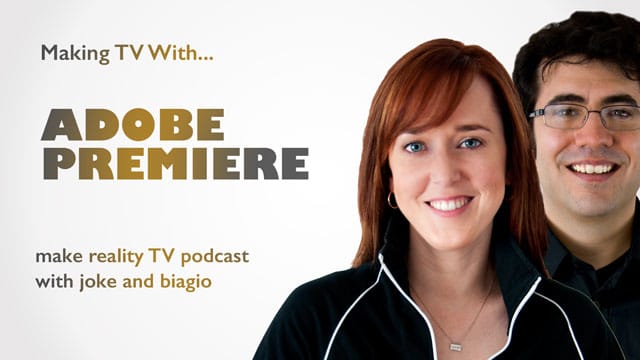Podcast: Play in new window | Download (Duration: 35:51 — 34.1MB)
Subscribe: RSS
People ask us all the time how we edit our TV shows. Until recently, it was a complicated, rambling answer filled with a mish-mosh of pseudo best practices. Not anymore. We’ve just taken our entire company in a brand new direction. We’re now making TV with Adobe Premiere and the Creative Cloud suite, and the results will be on national television in just about a week.
Can Adobe Compete in the Reality TV Industry?
Five years ago, like many, our production company Joke Productions would’ve shrugged off the idea of cutting our TV shows on Adobe Premiere. Our entire industry was run on Avid and Final Cut Pro (the pre X version) and no one thought about using anything else.
Then…Final Cut Pro was reborn as Final Cut X — and production companies everywhere freaked.
[tweet_box]Making TV with @AdobePremiere — we did it. Here’s how it went…[/tweet_box]
Many had chosen Final Cut Pro for its ability to composite in the timeline, have loads of audio tracks, and in certain situations, do more in less time. We were one of those companies.
While we still did occasional projects on Avid, so much of what we cut relied on heavy compositing, last minute changes, and numerous tracks of audio packed with sound design that it was less hassle to edit the shows in Final Cut Pro.
However, suddenly Final Cut Pro, as we knew it, was gone.
So What Do We Do Now?
One thing that makes our company a little different is that while we are the owners and executive producers, we’ve also both spent years personally working at edit bays.
Biagio is still lead (and often only) editor on all of our pilots and pitch tapes, and often edits on our series as well. Joke has spent many years stringing out story in edit bays.
Together we’d already both spent a great deal of time in Avid and Final Cut Pro over the years. Now we were getting up to speed in Final Cut X and Premiere so we could get our heads around the changing post landscape.
Basing our post decisions on hands-on experience has always been important to us. We don’t want to be executive producers waving our wands and saying “do it this way” without really understanding what we’re asking of our post team.
Since we knew what we really, really wanted out of an NLE (non-linear editor) we decided to try something crazy.
The Long Shot
We attempted to reach out directly to Apple, Avid, and Adobe, in hopes of telling them about our company, the wide variety of shows we make, and asking them to workshop with us to make their software work even better than what we were doing in FCP 7. (We didn’t actually know anyone at any of these companies.)
Both Avid and Premiere came to our offices to talk to us (hear the full story in the podcast ep above.)
Premiere had been doing some really interesting things for a while — integrating well with the outstanding Adobe After Effects and Photoshop (which we already used) and adding quirky new features that were unique to Premiere.
Adobe offered to work with us to tweak Premiere for the composite-heavy, resource-demanding brand of TV we were making.
But…no one had really battle-tested Premiere for the rigors of unscripted television.
Well, we’ve now battle tested it for a very, very long time.
Two Years Later
Everyone now knows Fincher cut Gone Girl on Adobe Premiere, but no one knew that during that time our (much smaller) company was investing countless hours into testing Premiere, or that Adobe was visiting our offices, listening to our concerns, and tweaking the software to work better for reality television.
Adobe Premiere: Reality Ready?
For two years we’ve not only heavily tested Premiere, but weighed all of our post production options. We have found Premiere to be more than “reality ready” and our personal tool of choice.
In fact, our new TV series was made with Adobe Premiere and heavy doses of Adobe After Effects.
Catch the results on Oxygen’s Snapped:She Made Me Do It when it premieres Wednesday, September 9th at 10pm / 9 central.
That said, there are things you’ll need to consider for your own post workflow. If you’re going to build an enterprise level server like we did, you’ll want to hire an expert to help you.
We cover that and much more today:
- Why consider Adobe when Avid is the industry standard?
- Is Final Cut X a viable option for a company like ours?
- How does Premiere hold up in a big, shared environment?
- What hardware considerations matter when numerous editors work on one project?
- How did we make our final decision?
- How was our new Oxygen series Snapped: She Made Me Do It enhanced by working in Premiere?
And so much more! Press that giant red “PLAY” button above and learn why we’re betting our company’s post production future on Adobe Premiere.
Transcript Coming Soon!
Helpful and Related Links
We’ll be live tweeting when our Adobe CC edited series Snapped: She Made Me Do It premieres Wednesday, September 9th at 10pm 9 central. Follow us here and tweet with #snapped to join the conversation.
Great post from Scott Simmons about why you should NOT let your editing system define you. After all, as Scott points out, great editors are storytellers, not button pushers. Couldn’t agree with Scott more.
Twitter account of The Phantom Editor, Edit Doctor, and the original Final Cut Pro Mike Nichols, who inspired us to seriously consider Premiere after FCP 7 died. Dude’s a genius, you should follow him.
Cool write up about David Fincher’s Adobe Premiere workflow over at Pro Video Coalition.
People ARE using FCP X for pro level work, just because it’s not for us, doesn’t mean it can’t be done. Good read, but we’re staying Premiere.
A post for you new editors — Steal This Editing Secret to Edit Film and Video Like a Pro.
Open Drives are the people we trusted to build our server for Premiere Pro. They’re amazing.
How we sold our new TV show to Oxygen, step by step.
If you’re reading this and wondering about breaking into unscripted television, you’re in the right place. One way to do that…pitch to us. Let’s make some TV together. Here’s how:

